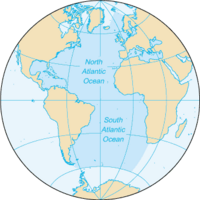
Photo from wikipedia
Trace metals, dichloro-diphenyl-trichloroethane (DDTs), polychlorinated biphenyls (PCBs), and polycyclic aromatic hydrocarbons (PAHs) were quantified in surface sediments from mud depocenters located in the western South Atlantic upper continental margin. There… Click to show full abstract
Trace metals, dichloro-diphenyl-trichloroethane (DDTs), polychlorinated biphenyls (PCBs), and polycyclic aromatic hydrocarbons (PAHs) were quantified in surface sediments from mud depocenters located in the western South Atlantic upper continental margin. There was no anthropogenic trace metal pollution observed, and the higher As values were attributed to high CaCO3 content in the area. The results indicate PCB sources associated with long-range atmospheric transport in addition to past DDT use for agriculture and pest control. PAHs were mainly originated from biomass and fossil fuel combustion, and their distribution is in alignment with the riverine runoff influence in southern region, which is transported towards the northern regions by coastal currents. Higher concentrations of 2-3 ring PAHs and DDTs in shallow and northern stations indicate a coastal influence. This work presents baseline information on the extent of anthropogenic influence in mud depocenters located in the western South Atlantic upper continental margin, showing these locations as potential source to sink of anthropogenic contaminants.
Journal Title: Marine pollution bulletin
Year Published: 2020
Link to full text (if available)
Share on Social Media: Sign Up to like & get
recommendations!